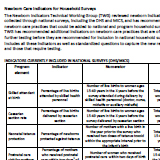
This tool includes indicators and questions for assessing newborn care services at facilities. It was developed by the Inter-agency Newborn Indicators Technical Working Group convened by the Saving Newborn Lives program at Save the Children. It can be used as a stand-alone tool or can be integrated into other health facility assessment tools. Its purpose is to allow a rapid assessment of newborn care services to determine the capacity of facilities at any level to provide care for well and sick newborns. In order to keep the tool short, tracer indicators were identified to assess whether a facility is able to address the three major causes of newborn deaths – intrapartum causes (birth asphyxia), preterm births, and infection.
This tool borrows heavily from the service provision assessment (SPA) tool developed by ICF International under the USAID-funded MEASURE DHS project, with the aim of using comparable questions and indicators in rapid assessments. The SPA was revised in 2011-12 with the Indicators TWG providing input on newborn care questions. This tool can also be used in conjunction with the Rapid Health Facility Assessment developed by ICF Macro in collaboration with MEASURE Evaluation for use by NGOs within the USAID Child Survival and Health Grants Program (CSHGP) and the World Health Organization’s Service Availability and Readiness Assessment (SARA) tool, which are rapid comprehensive tools that do not focus on the newborn. This tool is appropriate for projects, District Health Management Teams, or other parties that wish to collect more newborn specific information.
Users of this tool should collect information on a country’s policies and standards for each level of health facility, and use that information to frame the interpretation of findings. Lack of services or supplies can indicate potential gaps in policy or gaps in implementation, and an understanding of existing policies is necessary to make appropriate conclusions and recommendations. Information on policies and standards can be collected through document review or interviews with key policy people.
Indicators are divided into the following categories:
• Service availability (1-5)
• Equipment and supplies (6-16)
• Documentation (17)
• Trained staff (18-19)
• Supervision (20)
• Additional optional indicators (21-22)